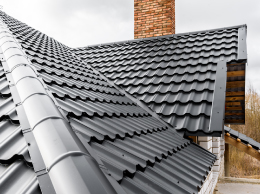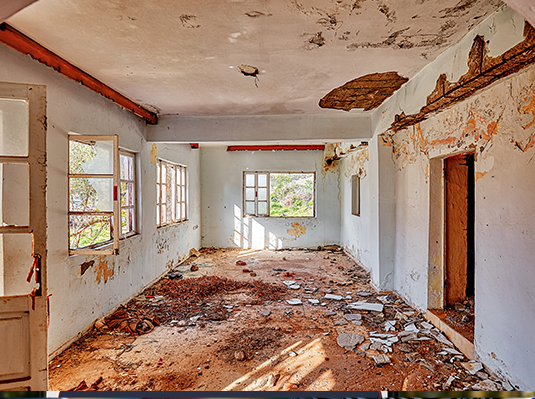
The roof of your home protects your family and personal belongings from the elements such as rain, wind, hail, and more, so naturally, it has to stand up to quite a bit of damage! That being said, the age of your roof, the type of your roof, and the way it is covered are some of the most important things to be aware of when looking at your homeowner's insurance. Let's take a look!
Roof Replacement Cost vs. Actual Cash Value - What's a schedule?
When it comes to the actual coverage that will be provided when a claim is filed, it is very important to understand that all policies do not cover you and your property the same. To put it simply, some policies will cover your roof in a way that will provide enough money, minus your deductible, to totally replace your roof with a new one. This is called Replacement Cost. Other policies may only pay out a depreciated amount, or a fraction of the cost to replace the roof. This is called Actual Cash Value.
-
Actual Cash Value: Actual Cash Value coverage is a way of covering your roof that limits the amount that you will be paid in the event of a claim. Basically, the insurance company will account for the depreciation on the current roof, and they will deduct this from the payout amount for the claim. The older the roof, the more they depreciate it, and the less they will give you. Here is an example that will show you exactly what we mean:
-
In early fall, a large hail storm comes through Mike’s area and causes severe damage to his roof. He has a roofer come out to inspect, and the verdict is that he is going to need a new roof. The roofer estimates that a new architectural shingle roof is going to run him $15,000. Mike calls his trusty insurance company to file a claim. An adjuster comes out, looks at the damage, and lets him know that they are accepting his claim, and he will be getting a check for $6,000 to replace his roof. Mike calls the claims department to get clarification. The claims representative explains that a brand-new roof for his home would cost $15,000, but his roof is 10 years old. He has used that roof for 10 years, so now it has depreciated to a valuation of $7,000. Mike has a deductible of $1,000. Due to these factors, the Policy will pay out $6,000, and Mike is responsible for the other $9,000 needed to replace the roof.
-
Replacement Cost: Replacement cost is the preferred way to insure your roof and other possessions. If your policy covers your roof at Replacement Cost, you will receive the amount needed to pay for labor and materials to replace the roof with a new one of similar kind and quality of the current roof. Let’s look at the same example from before, only assuming that Mike had Replacement Cost coverage on his roof, instead.
-
In early fall, a large hail storm comes through Mike’s area and causes severe damage to his roof. The same roofer comes out and assesses that the roof will cost $15,000 to replace. An adjuster from the insurance company comes out, looks at the damage, and lets him know that he will be getting a check for $14,000 to replace his roof since he has a $1,000 deductible that he is responsible for. The insurance company is aware that the roof is 10 years old, but this does not matter, because his roof is covered at Replacement Cost, so depreciation is not a factor in the payout amount.
Note: Learn more about how homeowner’s insurance deductibles work here.
-
There is a third option for roof coverage that you may run into. This option is called a Roof Payment Schedule. A Payment Schedule will function similar to Replacement Cost if the roof is brand new, but it will decrease the amount of coverage available as the roof gets older. For example, an insurance company may elect to the following schedule:
-
Roof 1-2 Years Old: 100% Replacement Cost
-
Roof 3-5 Years Old: 90% Replacement Cost
-
Roof 6-10 Years Old: 80% Replacement Cost
-
Roof 11-15 Years Old: 70% Replacement Cost
-
Roof 16+ Years Old: 50% Replacement Cost
-
Etc.
Now that you understand the difference, you may ask yourself, “Why would someone ever want to have their roof covered at Actual Cash Value?”. This is a great question, and the simple answer is that it is sometimes difficult to find a policy that makes sense and offers Replacement Cost. Insurance companies will be happy to insure a brand-new home with a brand-new roof at Replacement Cost. There is no reason to believe that the home is at a higher risk of having a claim on the roof because it is brand new with no pre-existing damage or wear. Now on the other hand, if we look at a home that has a 25-year-old composition shingle roof in an area with frequent hailstorms and high winds, insurance companies can assume that this home has a very high chance of experiencing roof damage. For this reason, a lot of companies may not offer Replacement Cost on the roof of this home. Other companies may charge a much higher premium in order to have Replacement Cost coverage. In these cases, someone may opt to have ACV coverage simply because they see no other way to afford the insurance. As long as the roof does not have pre-existing damage, there is usually an option to be found to get Replacement Cost coverage if we look hard enough.
Will homeowner’s insurance replace my roof when it gets old?
No, your roof will not be covered to be replaced if it just gets old. There has to be some sort of occurrence, or peril that causes the roof to have substantial damage.
Insurance, by design, was never meant to protect people from damage done by aging and normal wear and tear. In fact, wear and tear is one of the excluded perils that no insurance company will cover for. Insurance is here to be an option when something unexpected happens that would require you to pay large repair or rebuild costs. If you own a home, you can expect to replace your roof every 15-30 years depending on your location and roof type. Unless there is a covered peril that damages the roof, the insurance company will not pay out, and this will be another thing that is chalked up as an expense of homeownership.
In most cases, the homeowner’s insurance company will not pay out for cosmetic damage to your roof. If your metal roof has small dents in it from a hailstorm, but it still keeps all wind and precipitation out, most insurance companies will deny claims to replace it since it is still fully functional. Some carriers offer an endorsement to add cosmetic roof damage coverage, so be sure to ask your agent about this as well.
My roofer offered to pay my deductible.
This is always a red flag! It may seem tempting to go for such an offer, but there is always more to the story when the roofer offers to pay or absorb your deductible. Moving forward with such a deal is dishonest, and illegal in most states.
An insurance policy is like a contract or agreement between the insurance company and the client. The deductible is the portion of the claim that the client has agreed to pay, and the insurance company is expecting them to hold up their end of the deal. Roofers and contractors are always looking for ways to set themselves apart, and they sometimes come up with methods that are not entirely honest. Let’s first take a look at the way that deductibles work in the event of a claim.
-
In the event of a claim, the insurance company will typically pay out a check for the amount that the roof will cost to replace minus the deductible. Let’s use Mike’s example from before. His roof costs $15,000, and his deductible is $1,000. The insurance company will pay out $14,000, and Mike will be expected to pay the other $1,000 out of pocket to have the roof replaced.
-
A roofing company may feel that they can get an edge on the competition by getting the client out of paying the deductible. To do this, the roofer will change the estimate to show that the roof will actually cost $16,000 to replace. That way, the insurance company will send a check for $15,000, which is enough to pay for the full replacement of the roof.
On the surface, this may not seem like a huge deal, but remember, the policy is an agreement that says that the client will pay their part in the event of a claim. Partaking in this type of fraudulent activity can lead to claims being denied, and non-renewal or cancellation of your policy. Keep in mind that the roofing company may not be upfront about the fact that they are doing this. They may use words like “absorb”, “transfer”, or “deflect” in reference to the deductible to make it all sound like something normal. Many states have laws against this practice as the end result is higher premiums for the masses due to the inflated claims costs.
The contents of this article are for informational purposes only. You should not act or refrain from acting based on this information without first consulting a Goosehead licensed agent at [email protected]. We disclaim all liability for actions taken or not taken by you based on the contents of this article which is provided "as is." Goosehead makes no representation that this content is error-free.


